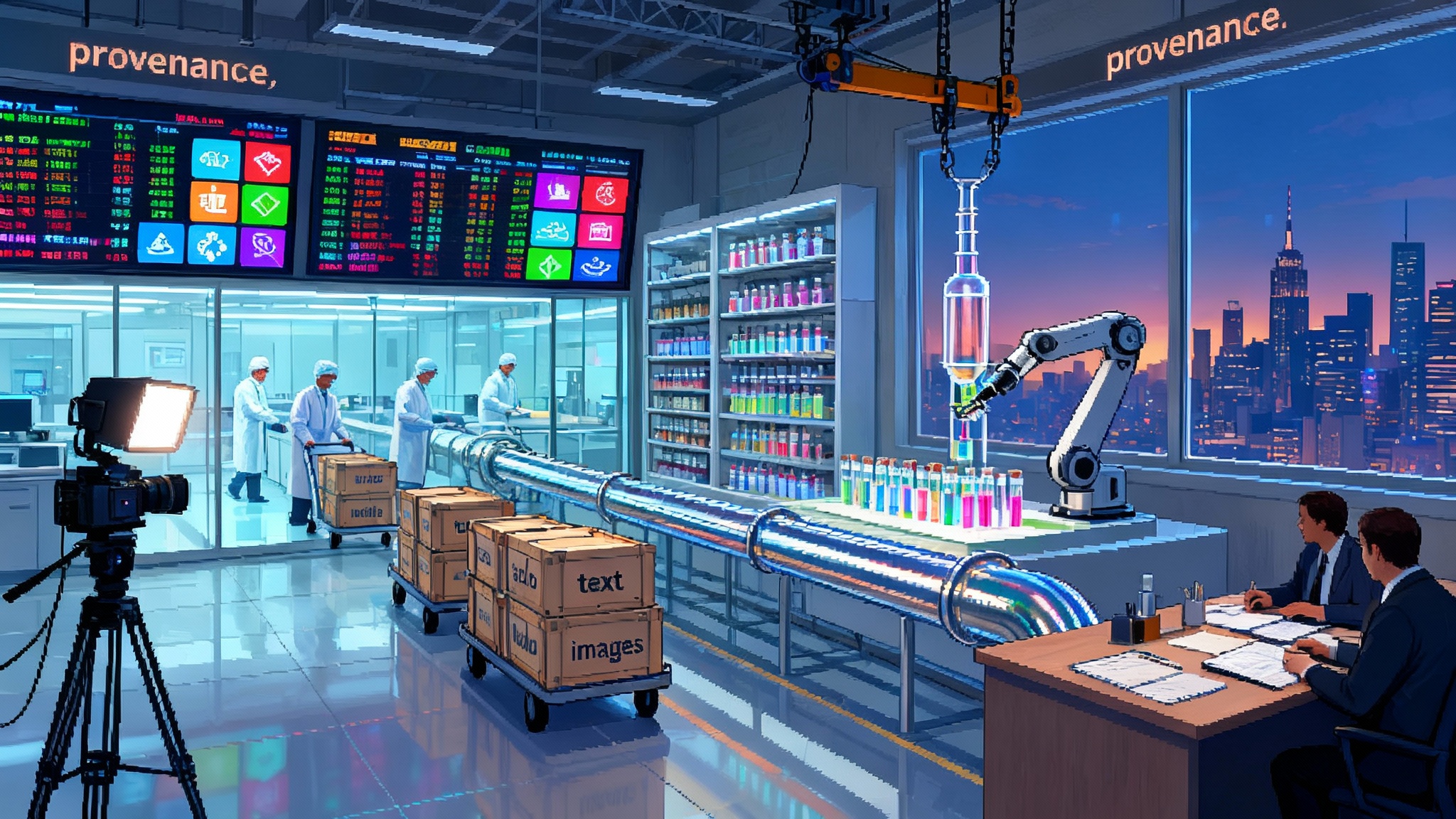Watermarks Go Live: C2PA by Default and NIST's Bake-off
A quiet switch flipped this week. Major platforms began showing C2PA provenance badges by default just as NIST released the first cross-model watermark stress tests. Trustable media now has a baseline, and incentives are about to shift.

The quiet flip that changes the feed
A change you can barely see is going to reshape what you see everywhere. In the last few days, major platforms turned on provenance badges by default for images and videos that carry standard C2PA manifests. At almost the same moment, the National Institute of Standards and Technology’s GenAI Safety Institute published initial, independent stress tests for invisible watermarks across multiple image and video models.
These two moves sound technical. They are not just technical. They reset the baseline for what counts as trustable media on the internet. One layer tells you who created a file and what happened to it. The other layer tries to tell you whether a file was machine generated, even after it has been resized, compressed, or remixed.
The timing matters. Provenance and watermarking have been stuck in pilot mode for years. Labels were opt in. Tests were vendor run. This week the defaults and the tests went public. Quietly, the incentives flipped.
Two layers, one idea: make origin visible
There are two complementary approaches at play.
-
Provenance via C2PA: This is a signed chain of custody. The creator or tool attaches a manifest to a file that states what it is, who made it, which steps modified it, and then signs that log cryptographically. If the manifest and signature travel with the file, anyone can verify them and see a badge.
-
Invisible watermarking: This is a signal hidden inside the pixels or frames. If you know the key or detection algorithm, you can infer whether content was generated or touched by a particular tool. Good watermarks survive typical changes like resizing or recompression. Great watermarks survive hostile editing.
These are not the same thing. A provenance badge is like a passport. It tells you the route taken, and the signatures can be checked. An invisible watermark is like a dye in the paper. It can still be present even if the passport stamp is missing, but it does not prove identity the same way.
The internet needs both. Provenance fails when metadata is stripped. Watermarks fail when the signal is washed out or forged. Together they can raise the cost of deception and lower the cost of verification.
How C2PA badges actually work
C2PA is a standard from a broad coalition of media, camera, and software companies. Tools that support it attach a manifest to a file. You can think of the manifest as a signed, tamper obvious notebook.
-
Each step of creation or editing can add an entry. A camera could add an entry that says it captured a photo. An editing app could add an entry that says it cropped or adjusted exposure. A generator could add an entry that says it synthesized an image from a prompt.
-
Each entry is signed with a private key. The corresponding public key can be used to verify that the entry is real and unchanged.
-
The UI piece is a small badge. Click it and you see a readable timeline. Which tool did what, when, and by whom if the author chooses to be named.
For users, the change you see now is simple. If a file has a valid manifest, platforms will show a badge by default. If a file is missing a manifest, nothing special appears. That does not mean the file is suspicious. It means you do not have a passport to inspect.
For builders, the change is more meaningful. You can now count on a consistent way to display and verify provenance at scale. That allows ranking and routing decisions to rely on a shared signal.
What invisible watermarks really promise
Invisible watermarks hide a small signal across the content so that it blends with noise. A detector later tries to read that signal. Designers juggle a few critical trade offs:
-
Robustness: Does the watermark survive resizing, heavy compression, color shifts, cropping, video re-encoding, or generative edits like inpainting and outpainting?
-
Detectability and false positives: How often does the detector claim a watermark is present when it is not? A high false positive rate is unacceptable in journalism, law, and advertising.
-
Capacity and cost: How much information can be embedded and at what computational cost per frame or image?
-
Imperceptibility: Does the watermark introduce visible artifacts, banding, or flicker, especially in darker scenes or gradients?
In practice, vendors use spread spectrum techniques, learned encoders and decoders, or a mix. Some embed in the frequency domain so the signal rides through compression. For video, some systems distribute the watermark across time so that frames support each other during detection.
Inside NIST’s first cross model bake off
Until now, watermark evaluations were mostly vendor run or limited to a single content type. NIST’s GenAI Safety Institute assembled a set of watermarks from multiple providers and research groups, then ran them through a common gauntlet. The goal is not to crown a winner. It is to make the landscape legible and to set baselines everyone can target.
What did they test? The focus was on survivability, accuracy, and performance under realistic conditions.
-
Standard transforms: Downscaling and upscaling, JPEG and HEVC recompression at low bitrates, cropping and padding, color space changes, gamma shifts, and noise injection.
-
Distribution artifacts: Screenshotting on desktop and mobile, screen recording, social platform re-encodes, and messaging app compression.
-
Physical world hops: Print and photograph, display and re shoot, projection and capture.
-
Generative edits: Inpainting and outpainting, style transfers, background replacements, super resolution, and model to model translation.
-
Adversarial attacks: Targeted denoising, blurs tuned to expected frequency bands, small random warps, and diffusion based “washing” that regenerates an image while trying to preserve semantics.
The measurements looked at true positive rates across stress levels, false positive rates, detection confidence distributions, and runtime costs for embedding and detection. Where possible, tests included cross model content so that one watermark had to survive content generated by another system, then altered by a third.
Early signals are cautious but useful. Watermarks vary widely in how they handle re encoding and generative edits. Many survive light edits easily. Fewer survive aggressive resizing, repeated platform compressions, or diffusion washing. Video marks face extra pressure, since temporal compression and rate changes can scramble signals.
The real contribution is not a leaderboard. It is a public yardstick. Vendors can now target a common stress suite. Platforms can calibrate their thresholds. Buyers can ask sharper questions.
A new baseline for trustable media
With badges on by default and a public test suite in motion, the slope tilts. The safest thing to do, for many workflows, becomes the default thing to do.
-
If you make or edit media in mainstream tools, your outputs can carry signed provenance by default.
-
If you host or rank media, you can show and factor in provenance at scale without custom deals.
-
If you need to infer whether something was synthesized, you can use watermark detectors that have at least been tested under the same pressures.
Trust does not arrive because of a stamp. It arrives because many actors now see a common path to lower risk and higher quality. That changes markets quickly.
Where the incentives go next
Follow the money and the routing. That is where the next moves will land.
Advertising and distribution
Ad networks and recommendation systems will begin to privilege assets with verifiable provenance. This is not about morality. It is about fraud and performance.
-
Ads with provenance reduce the chance of policy violations and legal disputes. That lowers review costs.
-
Verified ad creatives can be fast tracked, while unverified ones face slower lanes or lower reach.
-
News feeds and search results can boost verified media when topics are sensitive, or when policy requires auditability.
Expect soft rollouts. First it will be a nudge in the ranking algorithm. Then a toggle for sensitive topics. Later it becomes an explicit requirement for certain placements.
Marketplaces and stock libraries
Stock platforms and creator marketplaces will lean into badges to filter for originality and licensing. Provenance can carry licensing terms, model training disclosures, and machine generated flags.
-
Assets with a signed origin and clear edits will command higher prices.
-
Marketplaces can route suspicious items to manual review and reduce counterfeits by default.
-
Attribution improves. Buyers know whether they are licensing a human made photograph, a machine generated composite, or a hybrid with clear steps.
Enterprise compliance flows
Enterprises will wire provenance checks into their media pipelines. The reason is simple. They need audit trails.
-
Content management systems will verify manifests on ingest, store verification results, and propagate badges downstream.
-
Brand safety and legal review will gate on provenance or on watermark detection confidence when provenance is absent.
-
Procurement will prefer vendors whose outputs carry portable, standard manifests.
This is not just for media companies. Banks, retailers, and public agencies all publish media. They face discovery requests and regulatory scrutiny. A clean trail reduces exposure.
The arms race everyone expects
Success breeds pressure. As badges and watermarks shape distribution and payment, incentives to evade or confuse the signals will grow.
Evasion tactics to plan for
-
Metadata stripping: Removing C2PA manifests is trivial. That does not fool a verifier, it only removes the positive signal. Expect platforms to treat missing manifests differently in sensitive contexts.
-
Signal washing: Diffusion models can regenerate content from an input while trying to preserve the semantics and shed the watermark. Defense here is to make washing expensive, time consuming, or quality degrading.
-
Layered laundering: Attackers can apply a sequence of small edits that together exceed detection thresholds. Random crops, subtle warps, resaves, and color jitters in alternating order.
-
Collisions and spoofs: If attackers learn the structure of a watermark, they may try to forge positive detections or induce false negatives.
False positives and due process
False positives are the fastest way to lose trust. If a detector occasionally calls a human made image synthetic, policies need a clear response plan.
-
Use confidence and ensemble checks. Combine watermark detection with provenance status, contextual signals, and model consistency checks.
-
Design appeal paths. If a creator says a call is wrong, there must be a way to recheck with stricter thresholds or alternate detectors.
-
Log decisions. Keep the signals that drove a call. That helps audit and improves models over time.
A bad call can remove content, demonetize creators, or taint a brand. Due process is not optional.
What open weights do next
Open weight ecosystems face a question. Can they adopt compatible, durable marks without sacrificing creativity or speed? They have options.
-
Post hoc embedding: Add a watermark step after generation. This is simple and does not touch model weights. It may be less robust.
-
Training time embedding: Teach the generator to produce content that carries a watermark naturally. This can improve robustness and reduce visible artifacts. It requires retraining or fine tuning and may affect quality.
-
Hybrid schemes: Use a light training time bias plus a post hoc encoder to nudge outputs toward watermark friendly regions without harming diversity.
Concerns are valid. A heavy watermark can reduce dynamic range, introduce banding, or change the vibe of an art style. That is unacceptable for many creators. The bar is clear. Marks must be imperceptible to humans and cheap to compute.
Compatibility also matters. If open systems adopt marks that are not interoperable with platform detectors, creators get stranded. The good news is that NIST style test suites create a neutral forum to converge. What survives the gauntlet, ships.
How builders can ship now
You do not need to wait for another standard revision. The pieces are here.
-
For platforms: Turn on C2PA badge display for supported file types. Show a clear details view on click. Log verification status. Provide an upload hint when provenance is missing.
-
For toolmakers: Embed manifests by default. Offer creators a simple way to control which fields are attached. For watermarks, start with a robust, light touch encoder and run your own tests against the NIST style suite.
-
For enterprises: Insert a provenance verification step on ingest. Require manifests for high risk use cases. Add watermark detection as a fallback signal and log confidence scores.
-
For creators: Enable content credentials in your tools. If you work across apps, export with manifests and avoid workflows that strip metadata. Test how your platform of choice displays badges.
-
For researchers: Publish robustness under a shared set of transformations. Focus on attacker models that reflect real incentives, like diffusion washing on consumer hardware, not just textbook filters.
-
For policymakers: Avoid mandating a single technique. Instead, require disclosure and auditability for certain contexts and recognize both provenance and watermark signals as legitimate tools.
The emerging shape of trustworthy defaults
A year ago, provenance labels were a niche feature. Watermarks were a research checkbox. Today they begin to act like seatbelts. Most of the time you do not notice them. In a crash or a dispute, they matter.
This is not the end state. It is the start of an engineering cycle that will take a few years. As badges and watermarks move upstream into cameras and mobile operating systems, and downstream into ad networks and marketplaces, the connective tissue gets stronger. Friction drops. Incentives align.
If you build or distribute media, treat this week’s moves as a new baseline. Ship with provenance by default. Choose watermarking that survives the NIST gauntlet at an acceptable cost. Design for appeals. Measure what matters: robustness, false positives, and real world survivability.
The internet will not suddenly become honest. It will become legible. That is progress.
Clear takeaways
-
Turn on provenance now. If your tool or platform supports C2PA, enable badges by default. It lowers review costs and improves trust with minimal UX change.
-
Pick watermarks that survive your reality. Test against the transformations your content actually sees. Screenshots, social recompress, and light edits matter more than exotic attacks.
-
Design policies around confidence, not absolutes. Combine provenance, watermark detection, and context. Keep appeals in the loop.
-
Align incentives. Offer faster review or better placement for verified assets. Make the safe path the profitable path.
-
Converge on shared tests. Use NIST style stress suites so that vendors can improve against the same yardstick and buyers can compare honestly.
What to watch next
-
Ad network policies that grant higher reach or faster approval to verified creatives.
-
Marketplaces that require provenance for certain categories, with price premiums for verified originals.
-
Camera vendors and mobile operating systems shipping capture time manifests and hardware backed keys.
-
Second round NIST evaluations, with harder generative edits and cross modality tests for audio and video.
-
Open weight model releases that include optional, robust watermarking without quality loss.
-
Browser and messaging app UX that exposes provenance status before you forward or post.
-
Public reports on false positive rates and appeal outcomes to keep the system accountable.



